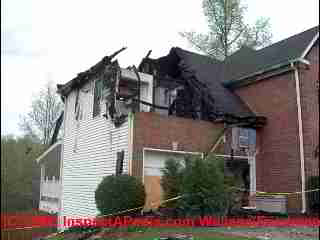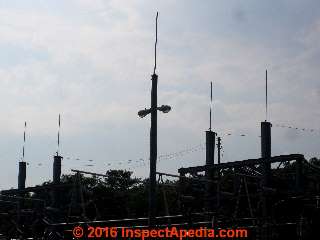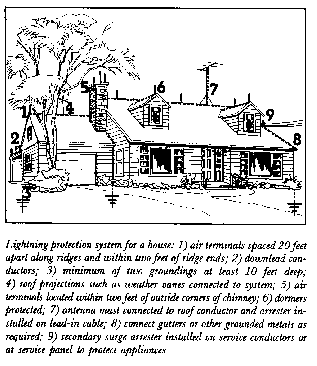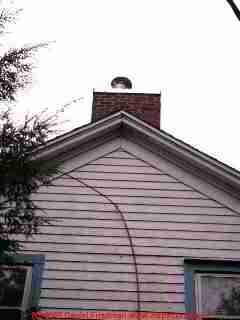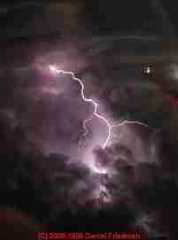 Lightning Strike Protection Systems
Lightning Strike Protection Systems
Home Page & Index to Articles
- POST a QUESTION or COMMENT about building lightning protection systerms
Lightning strike or bolt damage protection systems.
This lightning protection system website describes common lightning protection systems, certification, installation, and lightning protection system inspection. We provide information about lightning strikes, lightning hazards, related equipment, sources of lightning protection system installers, and lightning strike risk assessment.
The lightning bolt photograph at page top was taken by the author from an aircraft.
InspectAPedia tolerates no conflicts of interest. We have no relationship with advertisers, products, or services discussed at this website.
What is Lightning, What makes lightning strike? Which way does lightning move?
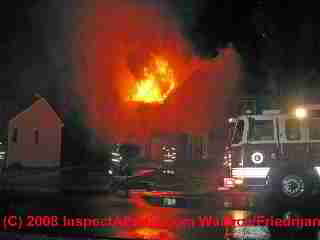
Example of lightning-related damage to a home: This house fire in Georgia was caused by a lightning strike in April, 2008.
According to UL, "lightning is the visible discharge of static electricity within a cloud, between clouds, or between the earth and a cloud". Thunderstorms occur when warm and cold air masses meet.
[Click to enlarge any image]
Charges of electrical energy build up within the air masses and periodically discharge as energy flows from one area to another.
Upwards-moving air in the churning caused where the cold and warm fronts meet causes a separation and movement of positively-charged ions or particles to the top of clouds, leaving negative charges at the bottom of clouds.
Lightning bolts may pass vertically or horizontally between clouds or may move between the air and the ground where energy is finally dissipated.
As lightning moves towards the earth (in the form of downwards flowing negatively charged electrical energy called a "pilot leader"), positive "lightning bolts" actually move upwards from vertical features on the earth such as the edges of buildings, chimneys or trees, reaching towards along an ionized path in the air towards the downwards-moving negative energy.
It's interesting that UL says the energy moves in discrete 150' steps, ionizing a pathway in the air.
Types of Building Damage Caused by Lightning Strikes
The photo above shows the extent of fire damage to the same house as the fire photo above. Damage to a home subject to a lightning strike and subsequent major fire could be expected to include:
- Lightning strike damage
to the home - damage caused by the lightning strike itself - Fire damage
to the home, caused by the subsequent fire resulting from the lightning strike - Water damage
to the home, damage to the structure caused by water used to extinguish the fire. In this instance water contacting bricks heated by the fire may have caused additional losses. - Mold contamination:
risk of damage to the structure from mold growth resulting from wet conditions in any wall, ceiling, or floor cavities or surfaces which were wet during the extinguishment of the fire, if these areas were not also promptly opened, wet materials removed, and the building dried quickly.
Our photographs of house fires caused by lightning strikes (above) were contributed by website readers.
UL adds that "Scientists still do not fully understand what causes lightning but most experts believe that different kinds of ice interact in a cloud. Updrafts in the cloud separate charges so that positive charges end up at the top of the cloud while negative flow to the bottom."
Our photograph of multiple lightning arrestor masts (left) shows a lightning protection system for an electrical power substation on the Hudson River.
[Our photograph of lightning shown at page top was of strikes moving between high clouds and was taken by the author from an airplane over northern Minnesota.]
When the negative charge moves down, a pilot leader forms. This lightning strike leader rushes toward the earth in 150 discrete steps, ionizing a path in the air. The final breakdown generally occurs to a high object and the major part of the lightning discharge is then carried in the return stroke which flows along the ionized path.
What is the Amount of Energy in Lightning Strikes? What Causes Thunder?
A lightning bolt that strikes the ground, "groundstroke lightning, is producing a tremendous electrical current, around 100,000 amps. (By contrast a typical home electrical panel supports 100 to 200 amps of current to operate everything in the home).
The energy in a 100,000 amp lightning strike can in turn produce very high temperatures, up to 50,000 deg. F (this is five times hotter than the surface of the sun!). It's the rapid heating (expansion) and then cooling (contraction) of air around a lightning strike that produces the shock wave (air movement) which is heard as a thunderclap during lightning storms.
Incidentally, while lightning is normally associated with thunderstorms, lightning strikes can also be caused by erupting volcanoes, hurricanes, forest fires, and (let's hope not) nuclear explosions.
A lightning protection system does not prevent lightning from striking; it provides a means for controlling it and preventing damage by providing a low resistance path for the discharge of lightning energy. [Quotations are from UL publication 200-128C 25M/9/93]
What Are Lightning Protection Systems?
A lightning protection system does not prevent lightning from striking; it provides a means for controlling it and preventing damage by providing a low resistance path for the discharge of lightning energy.
But lightning protection systems have a confusing history
The earliest lightning rod design, by Ben Franklin, ended in a sharp pointed trident which may have actually created an electrical field around the tip which invited strikes.
You'll notice that modern lightning rods have a short blunt tip and that they are connected to earth by heavy metal cables, often using braided copper.
Having a properly-designed lightning protection system is very important if you're going to have one at all, since an improperly designed or installed system might actually increase the chances of a building being damaged by a lightning hit.
Lightning strikes at buildings and other sudden electrical currents (such as a tree touching a high tension power line) produce very high voltages which can take surprising routes at a property such as following underground tree roots, metal porch railings, and copper or steel building water pipes.]
How do Lightning Protection Systems Work?
 Lightning protection systems control electrical discharges
by directing them through a low-resistance path to the ground, avoiding passage
through parts of a structure and reducing risk of fire or other damage.
Lightning protection systems control electrical discharges
by directing them through a low-resistance path to the ground, avoiding passage
through parts of a structure and reducing risk of fire or other damage.
Air terminals (rods - the sketch here is of a rod tip) are fastened to the building to intercept electric discharges which might otherwise strike a building component itself, such as a chimney or metal roof.
Electrical discharges striking the air terminal are directed through heavy duty metal conductors to a grounding system (rods driven into the soil) and thence into the earth.
The lightning protection system was first invented by Ben Franklin in 1752.
Example of a Damaged Lightning Protection System

We took these photographs of a damaged lightning protection system on an 1865 house in Orange County, New York.
The air terminal and conductor were bent down away from the top of the home leaving the chimney and roof (a metal one in an area of frequent lightning strikes) unprotected.
This is an example of what can happen when someone who is not qualified works on the system. The lightning protection system for this home was dangerously compromised when the maintenance crew simply bent components down out of their way.
[The photographs of details of an old lightning protection system shown here were NOT the work of any of the companies or sources described at this website.]
Lightning Protection System Research & Guides
For more details on how lightning protection systems work, see
- LIGHTNING PROTECTION [PDF] Pacific Electric and Gas Company, retrieved 2022/10/09, original source: https://www.pge.com/pge_global/common/pdfs/outages/current-outages/report-view-an-electric-outage/additional-resources/Lightning_Protection.pdf
- ELECTRICAL SYSTEM GROUNDING AND LIGHTNING PROTECTION [PDF] Engineering Technical Letter 90-6, Department of the Air Force, HQ USAF. - http://www.afcesa.af.mil/userdocuments/publications/ETL/ETL 90-6.pdf
- Fisher, Charles E., LIGHTNING PROTECTION for HISTORIC STRUCTURES [PDF] COMPLETE VERSION (2017) Preservation Brief No. 50, US NPS, US DOE, retrieved 2022/10/09, original source: https://www.nps.gov/tps/how-to-preserve/preservedocs/preservation-briefs/50Preserve-Brief-Lightning-Protection.pdf
Excerpt:
This Preservation Brief is designed for owners, property managers, architects, contractors, and others involved in the preservation of historic structures.
It includes information on the care, maintenance, and repair of historic and older lightning protection systems; discusses factors to consider in assessing the need for a lightning protection system where none exists; and includes historic preservation guidance on the design and installation of new systems - Lightning Protection, SECTION 620 GROUNDING AND LIGHTNING PROTECTION SPECIFICATIONS [PDF] - retrieved 2022/10/09
- Lightning strike risk assessment:
for the full body of this excellent article which summarizes recent opinions about lightning strike risk assessment and safe practices for individuals or groups needing to avoid being struck by lightning, see Updated Recommendations for Lightning Safety - http://www.nssl.noaa.gov/mag/holleetal.html 1998 Ronald L. Holle and Raul E. Lopez from National Severe Storms Laboratory, NOAA and Norman, Oklahoma, Christoph Zimmermann Global Atmospherics, Inc. Tucson, Arizona - As we indicated in an original version of this article, a lightning strike risk assessment guide can be found in Appendix I of the
National Fire Protection Association's Lightning Protection Code, NFPA #780.
The guide considers type of structure, type of construction, structure location, topography, occupancy, contents and lightning frequency. Contact NFPA, Batterymarch Park, Quincy, MA 02269 617-770-3000. - Lightning Protection Institute, 3365 N. Arlington Heights Rd., Suite J., Arlington Heights IL 60004
- MI, GROUNDING, BONDING, LIGHTNING PROTECTION AND SURGE PROTECTION FOR ELECTRICAL SYSTEM EQUIPMENT [PDF] Michigan DOT, retrieved 2022/10/09, original source: https://mdotcf.state.mi.us/public/dessssp/spss_source/20SP-826A-01.pdf
- NFPA 780 - Lightning Protection Code
- nVent LIGHTNING PROTECTION SOLUTIONS, NVent Erico Systems, Web: https://www.nvent.com/m retrieved 2022/10/09, original source: https://www.nvent.com/sites/default/files/acquiadam/assets/E1147C-WWEN.pdf
- Underwriters Laboratory Standard UL96A.
These requirements cover the installation of lightning protection systems on all types of structures other than structures used for the production, handling, or storage of ammunition, explosives, flammable liquids or gases, and other explosive ingredients including dust. These requirements apply to lightning protection systems that are complete and cover all parts of a structure.
Partial systems are not covered by this standard. These requirements do not cover the installation of lightning protection systems for electrical generating, distribution, or transmission systems. These requirements do not cover lightning protection components, which are covered by the Standard for Lightning Protection Components, UL 96. - Underwriters Laboratory Standard UL96:
These requirements cover lightning protection components for use in the installation of complete systems of lightning protection on buildings and structures.
These requirements do not cover the installation of lightning protection components. Products of this type are covered by the Standard for Installation Requirements for Lightning Protection Systems, UL 96A. - USAF, GROUNDING SYSTEMS, AIR FORCE INSTRUCTION 32-1065 [PDF] (2017) - retrieved 2022/10/09 original source: https://www.wbdg.org/FFC/AF/AFI/afi_32_1065_2017.pdf
Excerpt:
This instruction implements Air Force Policy Directive (AFPD) 32-10, Installations and Facilities. It assigns maintenance responsibilities and requirements for electrical grounding systems on Air Force installations, including systems for equipment grounding, lightning protection, and static protection. - "Lightning Awareness," Gerry Schulte, BMW ON magazine, June 2007 pp. 58-60, provided some technical details about lightning, and refers readers to www.lightningsafety.noaa.gov/outdoors.htm
- LIGHTNING PROTECTION FOR WORKERS [PDF] What to Do if You're Outside in a Lightning Storm - Center to Protect Workers' Rights (PDF)
Reader Comments, Questions & Answers About The Article Above
Below you will find questions and answers previously posted on this page at its page bottom reader comment box.
Reader Q&A - also see RECOMMENDED ARTICLES & FAQs
Reader Question: (July 26, 2012) Deji@Imon wireless said:
Good day to you. Please we are a Vsat solutions provider. and our operations is majorly in a terrain with high Ionic Content which brings us under serious lightning and thunder attacks.
Please, i would greatly appreciate if you could advice us on what to do and if you have products that could help us, we would appreciate if you could avail us the necessary details.
Reply:
Deji, Best would be for you to search InspectApedia for "lightning protection" and you'll find all of our information there.
...
Continue reading at LIGHTNING PROTECTION SYSTEMS, DEFINITIONS or select a topic from the closely-related articles below, or see the complete ARTICLE INDEX.
Or see these
Recommended Articles
- BUILDING SAFETY HAZARDS GUIDE
- GAS PIPING, FLEXIBLE CSST - lightning protection needed for flexible stainless steel tubing used as gas piping
- LIGHTNING BOLT FORMATION & MOVEMENT
- LIGHTNING DAMAGE to ELECTRICAL SYSTEM
- LIGHTNING PROTECTION SYSTEMS - home
- LIGHTNING PROTECTION SYSTEMS, DEFINITIONS
- LIGHTNING PROTECTION, HOW IT WORKS
- LIGHTNING PROTECTION SYSTEM DAMAGED, UNSAFE
- LIGHTNING PROTECTION SYSTEM CERTIFICATION
- LIGHTNING PROTECTION SYSTEM DESIGN
- LIGHTNING PROTECTION for TREES
- LIGHTNING PROTECTION, HIDDEN
- LIGHTNING STRIKE RISK ASSESSMENT
- LIGHTNING, AVOID BEING STRUCK BY
- LIGHTNING STRIKES SMALL BOAT
- METAL SIDING ELECTRICAL GROUND?
Suggested citation for this web page
LIGHTNING PROTECTION SYSTEMS at InspectApedia.com - online encyclopedia of building & environmental inspection, testing, diagnosis, repair, & problem prevention advice.
Or see this
INDEX to RELATED ARTICLES: ARTICLE INDEX to LIGHTNING PROTECTION SYSTEMS
Or use the SEARCH BOX found below to Ask a Question or Search InspectApedia
Ask a Question or Search InspectApedia
Try the search box just below, or if you prefer, post a question or comment in the Comments box below and we will respond promptly.
Search the InspectApedia website
Note: appearance of your Comment below may be delayed: if your comment contains an image, photograph, web link, or text that looks to the software as if it might be a web link, your posting will appear after it has been approved by a moderator. Apologies for the delay.
Only one image can be added per comment but you can post as many comments, and therefore images, as you like.
You will not receive a notification when a response to your question has been posted.
Please bookmark this page to make it easy for you to check back for our response.
Our Comment Box is provided by Countable Web Productions countable.ca
Citations & References
In addition to any citations in the article above, a full list is available on request.
- Portions of this information are based on UL publication 200-81 11/87 and other local service company information about lightning protection systems and lightning strike hazards.
[InspectApedia.com has no financial nor any other business relationship with any company or product discussed at this website--DF] - Special thanks to Associated Lightning Rod Company, Cooper Road Box 329A, Millerton NY who has been contributing technical content in presentations
to NY ASHI home inspectors since 1996. Web: http://www.alrci.com/
Some of that information [on lightning system material and installation details] was edited for clarity. ALRCi can be reached at 518-789-4603, 845-373-8309, 860-364-1498 and will inspect your lightning protection system at no charge.
- Armor Lightning Protection Inc Manchester Center, VT, 802-375-0266 state-of-the-art lightning protection and surge protection for residential and commercial buildings in Vermont, New England, and throughout the Northeast - Web: http://www.armorlp.com/
- Associated Lightning Rod Company, Inc., Box 329A, Cooper Road, Millerton, NY 12546 914/373-8309 518/789-4603
- A-C Lightning Security, Inc., 2100 East First St., PO Box 329, Maryville MO 64468 816-582-8115 800-821-5575 816-562-2932. In New York, Hudson Valley, contact Christensen Electrical Power Systems, Richard G. Christensen, 518-537-4128.
- Lightning Eliminators & Consultants 6687 Arapahoe Road Boulder, CO 80303 (303) 447-2828. "Engineering Solutions For Lightning, Grounding and Surge Protection Worldwide Since 1971" - Web: http://www.lightningeliminators.com/
- Lightning Protection for Facilities, Dr. Bruce Gabrielson, Robert B. Marcus, Published and presented: EMCEXPO92, Washington D.C. - web: http://www.blackmagic.com/ses/bruceg/EMC/litfacil.html
- MIT's Electrical Safety Files - http://web.mit.edu:1962/tiserve.mit.edu/9000/22714.html
- 1998 and Current Lightning Protection Conferences & Exhibitions - text file
- Lightning Risk and Hazard Analysis Measurement from the National Lightning Safety Institute (NLSI). web: http://www.lightningsafety.com/nlsi_lhm/lightning_risk_ham.html
- In addition to citations & references found in this article, see the research citations given at the end of the related articles found at our suggested
CONTINUE READING or RECOMMENDED ARTICLES.
- Carson, Dunlop & Associates Ltd., 120 Carlton Street Suite 407, Toronto ON M5A 4K2. Tel: (416) 964-9415 1-800-268-7070 Email: info@carsondunlop.com. Alan Carson is a past president of ASHI, the American Society of Home Inspectors.
Thanks to Alan Carson and Bob Dunlop, for permission for InspectAPedia to use text excerpts from The HOME REFERENCE BOOK - the Encyclopedia of Homes and to use illustrations from The ILLUSTRATED HOME .
Carson Dunlop Associates provides extensive home inspection education and report writing material. In gratitude we provide links to tsome Carson Dunlop Associates products and services.


